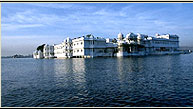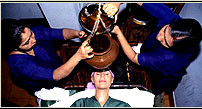Buddhist Sites
-| Lauriya Nandangarh | -
Location: Dist. Champaran W.Chauparan (Bihar) - Lat 26º 39'N, Long
84º 24' E
The site of Lauria-Nandangarh is located 30 kms. north-west of Headquarter Bettiah
in Bihar state.
Lauriya derived its name from a pillar (Laur) of Mauryan emperor Ashoka standing
there and Nandangarh being the name of a mound about 2 kms. to the south-west
of the Ashokan pillar. The polished, tapering, tall and singular well proportioned
capital has a single lion, placed on a circular abacus relieved with a row of
pecking geese, above a lotus.
Lauriya-Nanadangarh site has about 20 archaeological mounds in three rows -
one in east west alignment and the other two in north-south and parallel to
each other. The Asokan pillar stands near the two earlier most mounds of the
east-west row.
The excavation of the 82 ft. high mound yielded the ruins of a colossal stupa
that had a circumference of about 1500 ft near the base. This mound was known
as Nandangarh, and stood at a distance of two kms. from the south-west of the
pillar. The excavations also brought to light a large number of stone beads,
terracotta figurines, terracotta sealing of about the first century AD, punch
marked cast coins, thus proving that the stupa was erected during 2nd century
AD. Externally, the stupa rises in terraces, the basement and the lower two
terraces above the basement having a polygonal plan and the upper being circular.
The base and the two terraces above it evidently form the platform and the so
called circular terraces form the moulded base of the drum above the platform.
The facades of these polygonal terraces are relieved with plain moulded string
courses. The evidence of later restoration of the stupa is presented with new
circular walls in terraces along with three processional paths that were constructed
around the basement terraces and the first two terraces above the latter. In
the core of the stupa had a small polygonal stupa base. There were no relics
found inside but it was having a tiny copper casket, inside which there was
the long strip of a birch bark manuscript of about fourth century AD, the few
words which could be deciphered show that the manuscript represented a Buddhist
text. Probably the Pratitya Samutpada Sutra was written on the thin birch leaf
having been squeezed, into a tiny copper vessel with a lid fasten to it by a
wire.
Lauriya Nandangarh - Buddhist,
Archaeology in India
Reservation Form
 Special
Indian Tour packages Special
Indian Tour packages |



